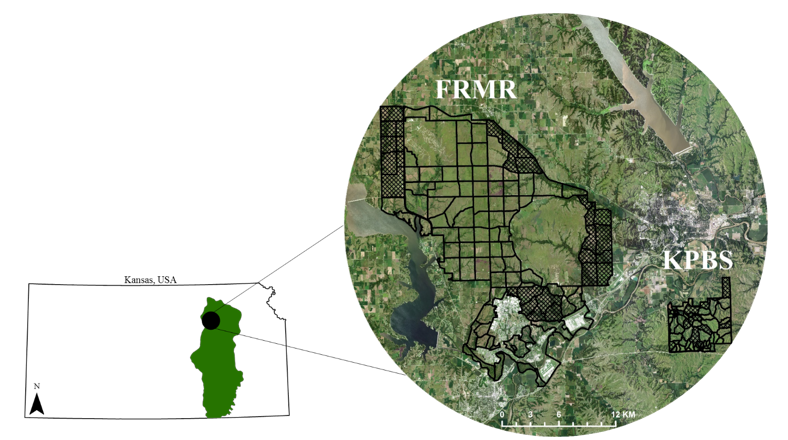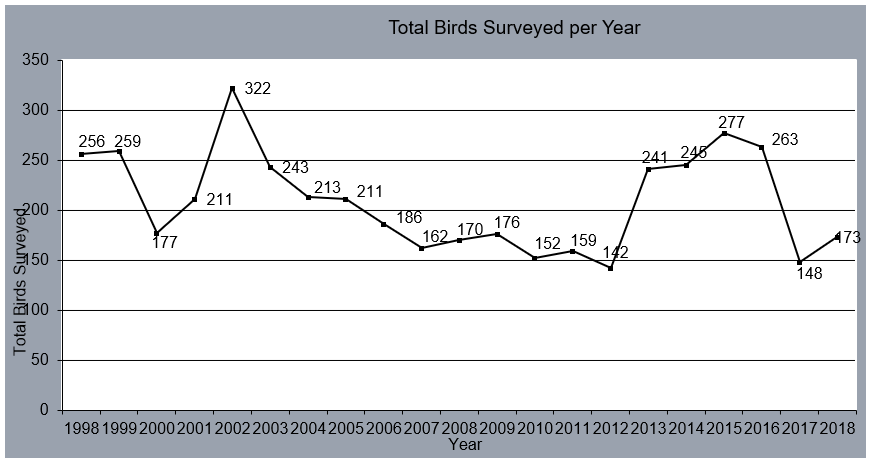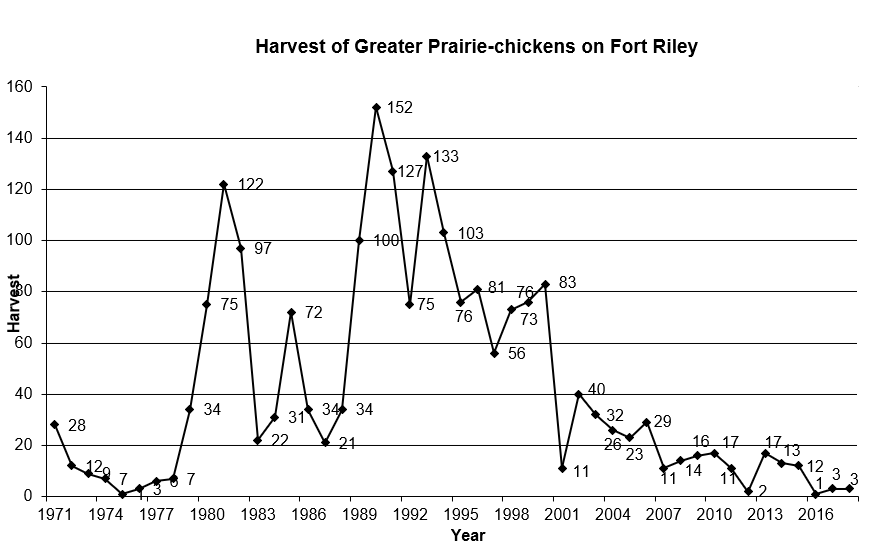Response of Greater Prairie-Chickens to Natural and Anthropogenic Disturbance on Fort Riley
Investigators: Jackie Gehrt, M.S. student
Principal Investigator: Dr. David Haukos
Funding Agency Collaborators: Department of Defense
Starting Date: 1 January 2019
Ending Date: 31 December 2021
Introduction: The greater prairie-chicken (Tympanuchus cupido pinnatus) is an iconic species of the Great Plains of North America, with a current occupied range stretching from Oklahoma nearly into Canada (Figure 1). Historically they probably occurred in 20 states of the United States and four Canadian provinces, but presently they only occur in 11 states and no longer in Canada (Svedarsky et al. 2000). Once numbering the millions across broad expanses of the Great Plains, the greater prairie-chicken is greatly restricted in range and much reduced in abundance since the late 1800s - early 1900s. Although there is not a current range-wide population estimate or information on abundance trends based on common survey methodology, most states have annual surveys of greater prairie-chickens and all indicate significant reduction in population occupied range and abundance (Johnson et al. 2011).

Figure 1. Historical and extant range of the greater prairie-chicken in North America. |
Range-wide population estimates compiled by Svedarsky et al. (2000) indicate that greater prairie-chickens have generally declined throughout their geographic distribution during the past 30 years. Declines have been precipitous in Oklahoma, which had an estimated 130,000 greater prairie-chickens in 1968 and 1,500 birds in 1997, and in Kansas, which had an estimated population of 530,000 greater prairie-chickens in 1989 and 160,000 by 1997. Range-wide estimates of the population vary between 370,000 and 690,000 birds distributed in 11 states (Svedarsky et al. 2000), with accelerated declines in the last decade. Cause for population declines include conversion of native prairie for development and crop production, inappropriate timing and intensity of livestock grazing, construction of roads, utility corridors, fences, towers, turbines, and energy developments, introduction and expansion of noxious weeds, alteration of fire regimes, climate change, and planting of trees (Robb and Schroeder 2005). In response to significant concerns regarding the status of greater prairie-chickens, the Midwest Association of Fish and Wildlife Agencies and Western Association of Fish and Wildlife Agencies created a Greater Prairie-Chicken and Sharp-tailed Grouse Interstate Working Group to expand and coordinate grassland conservation efforts using greater prairie-chicken and sharp-tailed grouse as flagship species. The long-term goal is to develop large blocks of native grasslands in sufficient sizes, arrangements, and quality to support populations of these two species, which will also support populations of a large number of additional grasslandassociated species.

Figure 2. Range of the greater prairie-chicken in Kansas |
Much of the extant range-wide population of greater prairie-chickens occurs in Kansas (Svedarsky et al. 2000, Robb and Schroder 2005). Greater prairie-chickens are found throughout the northern half of the state and in the Flint Hills extending southward into Oklahoma (Figure 2). Kansas is one of four states that allows harvest of greater prairie-chickens with

Figure 3. Area of Kansas open for hunting of greater prairie-chickens. |

Figure 4. Landcover map of Kansas indicating the Flint Hills (green). |
approximately 66% of the state open for hunting (Figure 3). Although much grassland habitat throughout Kansas has been converted to cropland, which has greatly fragmented much of the greater prairie-chicken range in Kansas, the tall-grass prairies in the Flint Hills were largely preserved, as shallow soils in the region precluded extensive cultivation (Figure 4; Applegate and Horak 1999). As grasslands became converted to cropland and quality of remaining habitat declined, the estimated greater prairie-chicken population in Kansas was reduced from 450,000 in 1968, 880,000 in 1979, 540,000 in 1985, 530,000 in 1989, and 160,000 in 1997 (Applegate and Horak 1999, Svedarsky et al. 2000). Within the past decade, the greater prairie-chicken population decline has intensified (Figure 5), to the point where Kansas Wildlife, Parks, and Tourism has become concerned about the status of the population and is actively contributing to conservation of the species across its range.

Figure 5. Population trend of greater prairie-chickens in Kansas |
It has become evident in the Flint Hills that landscape management practices (e.g., fire, haying, and grazing) in conjunction with anthropogenic structures (e.g., wind turbines, transmission lines, towers, roads) and encroachment of eastern red cedar (Juniperus virginiana) have greatly reduced the quantity and quality of greater prairie-chicken habitat leading to the population declines. Much of the grassland in the Flint Hills is managed though annual spring prescribed fire and early intensive stocking of cattle, which results in reduction of residual cover and forbs important for breeding greater prairie-chickens. This management practice is detrimental to greater prairie-chicken populations (Robbins et al. 2002, McNew et al. 2012a). In addition, habitat fragmentation and grazing intensity can negatively affect survival rates of greater prairie-chickens in the Flint Hills (McNew et al. 2012a). Nest-site selection and nest survival of greater prairie-chickens in the Flint Hills is closely related to vertical residual nesting cover, availability of which is determined by fire-return interval (McNew et al. 2015). Greater prairie-chickens respond positively to patch-burn grazing (pyric herbivory) by increasing nest density and success in unburned patches that are avoided by cattle (McNew et al. 2015). The occurrence of trees in the Flint Hills will cause greater prairie-chickens to leave a site, leading to the recommendation of implementation of a patch-burn grazing management strategy (McNew et al. 2012b). However, response of greater prairie-chickens to multiple large-scale disturbance in the Flint is unknown.
The Fort Riley Military Reserve is ~41,000 contiguous ha, making it the largest military reservation in the United States and one of the largest protected areas of the Flint Hills. Fort Riley is more than 10 times larger than Konza Prairie Biological Station (~3,500 ha; KPBS), which is a neighboring protected area where previous research on greater prairie-chickens has occurred (Figure 6). Located in the northern Flint Hills, approximately 29,000 ha of Fort Riley is used for military training, wildlife management, hunting, conservation, and other outdoor recreational activities (Figure 6). Land management is planned, prescribed to primarily control the establishment and spread of woody vegetation and includes broad-scale regimes of applied fire and hay removal. Prescribed fires are applied to large land units annually starting in late-winter and continuing through fall with the majority occurring in early spring. Managed fire frequency within land units range from <1 to >20 years, with occasional wildfires occurring throughout the year from lighting strikes and more frequent fires from the detonation of munitions during military training exercises. Prairie hay is cut and removed mechanically from 15 July – 15 August. Livestock grazing does not occur on Fort Riley.

In contrast to much of the Flint Hills, Kansas, and range-wide greater prairie-chicken population, the population of greater prairie-chickens on Fort Riley has remained relatively constant since 1998 (Figure 7). In addition, the number of leks (male display grounds) has also remained fairly consistent since 1998, with 18 leks counted in 2018 (Figure 8). Hunting of greater prairie-chickens is allowed on Fort Riley. Despite the relatively consistent population during spring lekking period, harvest has declined dramatically since the mid-1990s (Figure 9), with harvest nearly nonexistent since 2007. Potential reasons for the reduction in harvest includes (1) reduced hunting effort, which has occurred with the increasing restrictions; (2) greater prairie-chickens move off Fort Riley in the fall to unknown location; or (3) sharp declines in greater prairie-chickens in areas surrounding Fort Riley (e.g., KPBS) has reduced or eliminated movement of greater prairie-chickens to Fort Riley during fall. Seasonal movements by greater prairie-chickens on or off of Fort Riley are unknown.

Furthermore, there is a lack of understand the sensitivity and behavioral responses of greater prairie-chickens to large-scale, frequent, disturbance on Fort Riley. Intensive military training and exercises (i.e., tank, helicopter, and others) occur throughout the year on Fort Riley, including during the breeding season. Prescribed and wild fires occur throughout Fort Riley throughout the year. Finally, extensive haying occurs during late summer. Each of these activities, separately or in combination, may be affecting greater prairie-chicken lek placement, nest-site selection, movements, and survival. Given the increased concern regarding greater prairie-chicken populations in the Flint Hills, Kansas, and across the species range, information of greater prairie-chicken ecology, demographics, and resource selection on Fort Riley is needed to develop informed management strategies and assess effects of such disturbance on greater prairie-chicken populations.
 Figure 8. Location of 18 greater prairie-chicken leks on Fort Riley during 2018.
Figure 8. Location of 18 greater prairie-chicken leks on Fort Riley during 2018.

Study Objectives:
(1) Determine annual lek locations and model the relative effects of landcover (e.g., vegetation types, Ecological Site Descriptions) and disturbance (i.e., military activities, fire, and haying) on the placement of leks and number of greater prairie-chickens attending leks.
(2) With the use of satellite, GPS radio collars, estimate movements, home range, nest- and brood-site selection, and survival of greater prairie-chickens on Fort Riley.
(3) Measure resource selection of vegetation at multiple orders of selection, in particular home range placement and 4th order point selection.
(4) Determine the relative influence of disturbance events on intensity of space use (e.g., home range placement, within home range locations) using resource utilization functions.
Methods:
Due to military activities, including live fire training, field activities will be conducted in coordination with Fort Riley Environmental Division and training commander. Spring lek observation and capture will be restricted to the last week in March and first 2 weeks of April (NLT 15 April), which is the peak female lek attendance period. Vegetation measurements associated with point, nest, and brood locations will be recorded within restrictions of military training activities.
During 2019-2020, we will develop annual land cover and land use layers for Fort Riley. These layers will include fire history, haying locations, and area affected by military activities. In addition, information of timing of disturbance will be collected to relate to responses by greater prairie-chickens. Patches (areas >2.5 ha with common land cover and land use) will be delineated and FRAGSTATS will be used to characterize both patch (e.g., mean patch size, area-weighted patch size, patch edge) and landscape level (e.g., contagion) metrics across Fort Riley.
Spatial information for leks will be recorded including training area, land cover, land use, time since fire, time since haying, distances to anthropogenic features (e.g., roads, power lines, towers), elevation, and distance to trees or tree density. Location and area of leks will be marked with a GPS unit. Lek vegetation composition (step-point species composition) and structure (visual obstruction reading, litter depth) will be measured and recorded at each lek and along 2-3 100-m transects radiating out from each lek. Lek observations will include counts of the number of males and females attending and physical size of the lek. Characteristics of lek locations on the landscape will be compared to random locations using logistic regression to determine relative influence of measured variables on lek establishment. Poisson regression will be used to determine factors that influence the number of attending greater prairie-chickens.
During 2019 and 2020, our goal will be to capture and attached radio transmitters to 25 female greater prairie-chickens each year (50 total for the project); however, transmitters will be attached to males should the female goal not be attained. Capture will include use of passive walk-in traps and active drop nets (manual and magnetic). Captured birds will be aged and sexed based on plumage characteristics (i.e., tail coloration, spotting on primary wing feathers). Following capture, all birds will be banded with an aluminum numbered leg band and the following morphometric measurements will be recorded: body mass, flattened wing chord, tarsus, pinnae length, middle toe, head length, and eyebrow length (males).
We will fit up and maintain up to 25 birds/year with 17- or 22-g solar-powered Argos GPS satellite transmitters (Model PTT-100, Microwave Telemetry, Columbia, Maryland, USA; ~$4,000/unit). Transmitters will be mounted with a rump attachment. Duty cycles will included 10 points from 0400 – 2200 from 1 March – 31 September and then 6 points from 0800 – 2200 from 1 October – 28 February. Data downloads will be every three days via the CLS America subsidiary (aka Woods Hole) of Argos Inc. Daily or weekly survival will be determined using Known-Fate survival models in Program MARK or using a Kaplan-Meier estimator. Anderson-Gill models may be used to evaluate relative hazard risk for factors (e.g., landscape metrics, anthropogenic structures) potentially influencing survival. Cause-specific mortality will be evaluated for each dead bird.
Movements will be grouped as described by Earl et al. (2016), with distances and habitat/landscape characteristics measures or derived for each location. Home range area will be determined using Brownian-Bridge Motion algorithm for GPS-PTT marked birds. Initiation of nesting and incubation will be determined remotely using constant PTT locations. Estimates of clutch size and basic nest site vegetation characteristics will be recorded (e.g., plant height, composition, visual obstruction) following determination of nest fate, which will be when the hen is off the nest for >1 day or a mortality signal is detected. Nest vegetation will be measured at date of expected hatch based on when incubation was estimated to begin if the nest was unsuccessful. Nest location will be recorded using a GPS to allow for later measurements at the landscape scale (e.g., distance to edge, distance to anthropogenic features). Daily nest survival will be determined using Program MARK with multiple environmental and other covariates tested for influence on survival (e.g., incubation stage, temperature, precipitation). Vegetation characteristics between nest sites and random points within 50 m and characteristics of the habitat patch using multivariate statistics (e.g., ordination, MANOVA). Nest site selection will be determined using compositional analysis and resource selection functions at second and third order selection scales. Females with broods will be followed up to 60 days post-hatch, with initial flush at 30 days to determine presence and number of associated chicks.
Vegetation characteristics of 3-4 points/week/bird will be measured (e.g., Daubenmire horizontal cover, plant composition, visual obstruction) at the estimated location and associated random points at various scales (within 4 m, 10 m, 20 m, and 50 m) of the point. Line transects will be used to characterize vegetation at the patch scale across the study area. Use will be characterized by percent occurrence within a cover type or ecological site description. Habitat selection will be determined using resource selection functions, resource utilization functions, or compositional analyses with availability estimated at the individual and composite home ranges for each site.
Educational Training Experience for the Graduate Research Assistant:
The scope of work for this Research Work Order includes training opportunities for one Graduate Research Assistant, MS level, and the budget provides a salary stipend and fringe benefits, including tuition costs, for this position. The anticipated start date for the research associate will be January 2019 and will extend until September 2021. The research assistant will be under the direct supervision of Coop Unit Leader David Haukos, but will receive additional mentorship from the formed graduate thesis committee and other post-doctoral research associates (2) and graduate students (9) supported by the Kansas Coop Unit. The research assistant will be expected to participate in proposal development, data collection, data analysis, manuscript writing, and presentation. The research assistant is expected to collaborate with off-campus research partners, including interacting and in consultation with Shawn Stratton, Jeff Keating, and Mike Houck (Fort Riley Environmental, Conservation) and other collaborators with the DOD, USFWS, KSU, and KDWPT. Activities will include collection of data regarding greater prairie-chicken occurrence, density, movements, and vital rates. The graduate research student will learn how to manage large spatial data bases, conduct landscape level analyses, and develop spatial models to predict movements, space use, and resource selection of greater prairie-chickens in tall-grass prairie. Results from the project will assist Department of Defense and other land managers, conservation organizations, and state and federal agencies as a decision support tool in Kansas. Similar approaches could be adopted by other states. Research results from this project will assist natural resource managers, conservation organizations, and government agencies in development management plans for greater prairie-chickens on military installations in the mid-western United States
Literature Cited:
Applegate, R.D., and G.J. Horak. 1999. Status and management of the greater prairie-chicken in Kansas. Pages 113-122 in W.D. Svedarsky, R.H. Hier, and N.J. Silvy, editors. The greater prairie-chicken a national look. Miscellaneous Publication 99-1999, Minnesota Agricultural Experiment Station, University of Minnesota, Saint Paul.
Johnson, J. A., M. A. Schroeder, and L. A. Robb. 2011. Greater Prairie-Chicken (Tympanuchus cupido), version 2.0. In The Birds of North America (A. F. Poole, Editor). Cornell Lab of Ornithology, Ithaca, NY, USA. https://doi.org/10.2173/bna.36
McCullough, K. 2016. A multi-scale examination and habitat use patterns of the regal fritillary. Thesis, Kansas State University, Manhattan.
McNew, L.B., T.J. Prebyl, and B.K. Sandercock. 2012a. Effects of rangeland management on the site occupancy of prairie-chickens in a protected prairie preserve. Journal of Wildlife Management 76:38-47.
McNew, L.B., A.J. Gregory, S.M. Wisely, and B.K. Sandercock. 2012b. Demography of greater prairie-chickens: regional variation in vital rates, sensitivity values, and population dynamics. Journal of Wildlife Management 76:987-1000.
McNew, L.B., V.L. Winder, J.C. Pitman, and B.K. Sandercock. 2015. Alternative rangeland management strategies and nesting ecology of greater prairie-chickens, Rangeland Ecology and Management 68:298-304.
Robb, L.A., and M.A. Schroeder. 2005. Greater Prairie-Chicken (Tympanuchus cupido): a technical conservation assessment. [Online]. USDA Forest Service, Rocky Mountain Region. Available: http://www.fs.fed.us/r2/projects/scp/assessments/greaterprairiechicken.pdf
Robbins, M.B., A.T. Peterson, and M.A. Ortega-Huerta. 2002. Major negative impacts of early intensive cattle stocking on tallgrass prairies: the case of the greater prairie-chicken (Tympanuchus cupido). North American Birds 56:239-244.
Svedarsky, W. D., R. L. Westemeier, R. J., Robel, S., Gough, and J.E. Toepher. 2000. Status and management of the greater prairie-chicken Tympanuchus cupido pinnatus in North America. Wildlife Biology 6:277-284.
